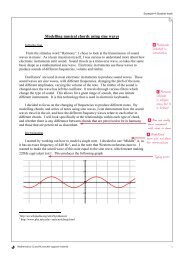The Polar Area Diagrams of Florence Nightingale - debbiebaker
The Polar Area Diagrams of Florence Nightingale - debbiebaker
The Polar Area Diagrams of Florence Nightingale - debbiebaker
You also want an ePaper? Increase the reach of your titles
YUMPU automatically turns print PDFs into web optimized ePapers that Google loves.
Example 6: Student workbecame sure that she did mean them to be overlapped. I noticed that in the lefthand rosein figure 1 (representing the second year) there is a wedge with blue at the edge followedby a wedge with blue at the edge:Figure 5A zoom in <strong>of</strong> part <strong>of</strong> figure 1"Blue" is atyping error.This can happen in a diagram like my figure 2 <strong>of</strong> overlapping colours, but would beimpossible if the colours are separate as in figures 3 and 4. From this I deduced that thecolours on the diagram must be overlapping.<strong>The</strong> Second ProblemMy diagrams were unlike <strong>Nightingale</strong>’s ones in that the total area <strong>of</strong> the sectors in figure2 represented the total number <strong>of</strong> students taking the IB at this school over the 15 years.<strong>Nightingale</strong>’s statistics were rates <strong>of</strong> mortality. Basically they can be thought <strong>of</strong> aspercentages <strong>of</strong> soldiers who died, but, as before, when I read through the articles again, Iwas unsure what they were percentages <strong>of</strong>. Gill and Gill have table (Table 2) in theirarticle with headings “No. <strong>of</strong> soldiers admitted to the hospital” and “No. (%) <strong>of</strong> soldierswho died” 3 . This might suggest that <strong>Nightingale</strong> was working with percentages <strong>of</strong>soldiers who were admitted into hospital. Lewi is more definite and refers to the actualstatistic <strong>of</strong> one wedge <strong>of</strong> the third <strong>of</strong> <strong>Nightingale</strong>’s polar area diagrams as follows: “<strong>The</strong>mortality during the first period was 192 per 1,000 hospitalized soldiers (on a yearlybasis)” 9 . However, Brasseur refers to the statistic in a wedge <strong>of</strong> <strong>Nightingale</strong>’s firstdiagram as being “the ratio <strong>of</strong> mortality for every 1,000 soldiers per annum in the field” 4 ,in other words a percentage <strong>of</strong> the army actually on duty.I decided to create a polar area diagram to act as an analogy to the possible situations asfollows:<strong>Nightingale</strong>’s dataMy dataNumber <strong>of</strong> soldiers in the army in a month Number <strong>of</strong> students taking the IB in a yearNumber <strong>of</strong> soldiers taken to hospital Number <strong>of</strong> students taking Maths StudiesNumber <strong>of</strong> soldiers dying <strong>of</strong> wounds Number <strong>of</strong> students gaining grade 7Number <strong>of</strong> soldiers dying <strong>of</strong> disease Number <strong>of</strong> students gaining grade 6Number <strong>of</strong> soldiers dying for other reasons Number <strong>of</strong> students gaining grade 5My analogy <strong>of</strong> drawing a diagram showing the numbers <strong>of</strong> soldiers dying as a percentage<strong>of</strong> those admitted to hospital would then be the number <strong>of</strong> students gaining a grade above4 as a percentage <strong>of</strong> those taking Mathematical Studies. I decided to do this one by hand,partly to prove I could, and partly to see if it would throw any extra light on theconstruction <strong>of</strong> the diagrams.D Very goodexample <strong>of</strong>critical reflectionC Another goodpersonal exampleMathematics SL and HL teacher support material 6







